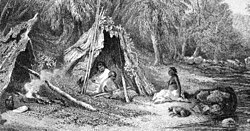Difference between revisions of "AY Honors/Aboriginal Lore/Answer Key"
From Pathfinder Wiki
< AY Honors | Aboriginal LoreAY Honors/Aboriginal Lore/Answer Key
| (One intermediate revision by the same user not shown) | |||
| Line 1: | Line 1: | ||
| + | [[Image:Indig1.jpg|thumb|250px|A 19th century engraving showing Aboriginal people and humpy.]] | ||
| + | |||
A '''humpy''' is a small temporary shelter made from bark and tree branches, traditionally used by [[Australian Aborigines]]. A standing tree is usually used as the main support. The word humpy comes from the [[Jagara]] language (a [[Murri]] people from [[Coorparoo]], [[Brisbane]]). Other [[Australian Aboriginal languages|language groups]] would have different names for the structure. | A '''humpy''' is a small temporary shelter made from bark and tree branches, traditionally used by [[Australian Aborigines]]. A standing tree is usually used as the main support. The word humpy comes from the [[Jagara]] language (a [[Murri]] people from [[Coorparoo]], [[Brisbane]]). Other [[Australian Aboriginal languages|language groups]] would have different names for the structure. | ||
Revision as of 02:56, 12 November 2006
A humpy is a small temporary shelter made from bark and tree branches, traditionally used by Australian Aborigines. A standing tree is usually used as the main support. The word humpy comes from the Jagara language (a Murri people from Coorparoo, Brisbane). Other language groups would have different names for the structure.
The word humpy was adopted by early white settlers, and now forms part of the Australian lexicon. Small impermanent dwellings, including of canvas, were often referred to as humpies.
It is sometimes called a lean-to, since it relies on the tree for support.

